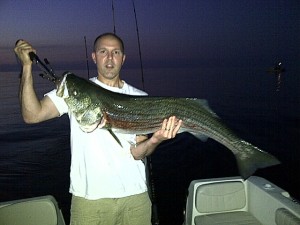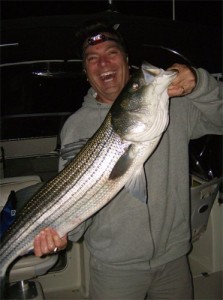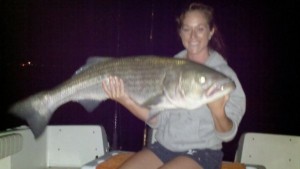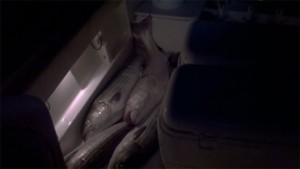I was 15 years old when I first began hearing stories about guys catching big bass on the tube and worm at night.
I was working part-time at a bait shop in my town, and heard many fish tales and exaggerated stories on an almost daily basis. However I knew these stories about catching big bass at night on the tube were true. They were told by credible sources, plus everyone knew that big bass fed more aggressively during the night.
To say I was intrigued would be a severe understatement. Obsessed is probably a more appropriate term. To my mother's dismay, these stories fueled my passion for fishing at night.

In the beginning my efforts went, for the most part, unrewarded. I came to grips with the fact that there is a ton of water out there, and that bass could pretty much be anywhere. The vastness of the night time ocean can be an overwhelming opponent.
For the first few years my father and I fished "blind," with no sonar and nothing more than a hand held GPS to guide our way. We logged some seriously cold, wet and uncomfortable hours out there in my father’s 19 foot Carolina Skiff.
I give my Dad a lot of credit for sticking it out. I'd imagine most fathers would not be willing to spend their summers in nocturnal fashion, led into the night time abyss by a 15 year old's hunch that big fish loomed out there, somewhere. We spent many fruitless, uneventful hours trolling aimlessly into the night.
Then, finally, it happened.
The trip occurred during a hot and humid mid-August night, sometime during the early 2000's. The sky was lit up with meteors and stars. It was a perfect Cape Cod night.
Out on the horizon was a lone set of navigational lights. We trudged our way westward towards the lights-hoping that we may have found one of the sharpies I had heard about at the bait shop. We gave the boat plenty of room, and began trolling the area.
It could not have been more than five minutes until the port side rod doubled over! I could not believe it! Here we were, in what seemed like the middle of nowhere, with a big bass on the line.
We boated that fish, which measured all of 45 inches. Tubes went back in the water and within another minute we were tight again with another 30 pounder. As soon as we set the tubes the drags began screaming under the strain of heavy striped bass. We continued in this fashion until the sun poked it's bright head over the horizon. Final tally was 9 bass between 20 and 35 pounds.

As a 15 year old I was absolutely ecstatic. I had received my first hit of what night trolling the tube and worm is all about, and I was instantly addicted.
For me, the experience proved that big bass really do crush the tube and worm at night. However that trip also spurred many more questions that would fuel my passion for years to come.
11 years later I still find myself spending more than 50 nights a season on my boat, in the pitch black, trolling tubes for big fish.
Safety at Night
The most important thing, especially when fishing at night, is safety. Getting out on the water safely, and returning back to the dock safely is always the #1 priority. Everything else is just a bonus.
Having reliable electronics is an absolute must. Radar certainly helps provide some added peace of mind. A good GPS unit is definitely a must have. Of course none of these electronics will help unless you possess a firm understanding of how to operate them.
Bright spot lights are also very important. Million candlepower hand held versions do the job just fine. If you suspect the captain of another boat does not see you, nothing will get his attention quicker than a direct shine from a spot light.
As always a VHF radio, life jackets and all other Coast Guard required safety equipment should be on board.
Working navigation lights and an anchor/stern light are a must. The ability to determine the movement of other boats based upon the orientation of their navigation lights is a very important skill.
The most important safety measure at night is to do everything at half speed. Do everything slower at night than you normally would during the day. Keep your head on a swivel. Pay attention to your surroundings first and the fish second.
Fortunately all of my night fishing takes place along sandy beachfront devoid of boulders and current. It's a relatively safe environment for night fishing. Obviously extra caution needs to be taken around navigational hazards.

The weather has a greater impact on safety at night than during the day. Being stuck in fog on a pitch black night can be a nightmare. Even light drizzle can decrease visibility to a matter of a few hundred feet. Keep in mind that you will never see that slightly larger wave coming in the dark.
Even crystal clear nights can be dangerous. Light pollution from land can make keeping tabs on the navigational lights of other boats difficult. Tugs, tankers, and barges are notoriously poorly lit, and thus blend in easily with the lights on land.
Shoaling Bass Behavior at Night
Generally speaking I have found that most areas fish better at night. If fish are being caught during the day in a certain area, then more than likely more fish can be caught in the same area during the night.
Be sure to remember that there are many exceptions to this rule. However fishing for striped bass at night usually results in more and bigger fish hitting the decks.
Often time’s areas completely devoid of life come alive once the sun goes down. A good area to target at night is one in which at least a few bass were caught during the day. If folks are picking away at a few fish here and there when the sun is high in the sky, then there is a good chance that the area could be stacked with bass once it gets dark.
For the sake of simplicity I like to categorize bass behavior as either schooling or shoaling, and resting or feeding. I am going to focus on true shoaling behavior in this section, because of its interesting connection with night fishing for striped bass.
When it comes to fishing at night, I find shoaling to be one of the most intriguing of bass behaviors. Throughout the blog I have used the term shoaling to represent any situation in which bass are spread out amongst a large expanse of water.
However the true meaning of shoaling is slightly different than the way in which I have been using the term. Schools of fish are usually shaped in a rather tight, circular or cylindrical fashion. Shoaling fish, on the other hand, spread out in random formations. One fish may be oriented towards the east, another to the north, another to the south etc. Each fish is spaced out rather evenly throughout a stretch of water.
Shoals of striped bass can number well into the thousands.
For reasons unbeknownst to me, large schools of striped bass will occasionally shoal close to the surface at night. Each individual bass will be rather evenly spaced throughout a stretch of water.
Over the past few years I have on many occasions found stretches of water in which bass were evenly spaced out every ten yards or so for miles on end. Without exaggeration, we have had nights in which we trolled for three miles, marking a bass here and there the entire time.
Another interesting observation is that in these instances, the bass would more than likely be holding 10 feet deep-even though we found them in water as deep as 80 feet. For whatever reason, these bass hung close to the surface. For all I know there could have been big bass hanging out even shallower than 10 feet that did not register on my sonar.
Often time’s bass would return each night to the same general stretch of water, located 2-5 miles from shore. These areas are most often located just offshore from well-known day time hot spots. I encountered this type of behavior most often during the middle of the summer.
At some point during the course of the night, usually just before dawn, these stretches of water "dry up" and the bass "disappear." Odds are that the fish have simply changed behavior, and have once again schooled up for the day. It's very unusual to find bass in true shoaling mode at any other time but during the depths of the night.

Bass behavior during the night also changes from year to year. For example I only experienced one night this entire season in which bass exhibited this type of shoaling behavior. I found this to be very surprising, since I encountered shoaling bass on a weekly basis during the summer of 2010.
In my area this season, the best bite occurred from dusk until midnight. This was also very different compared to the 2010 season. During 2010, the bite would often last the entire night. In past seasons the best bite would begin around 2AM.
Again, I really have no idea why certain behaviors change so much from year to year, while other behaviors remain rather consistent. Your guess is as good as mine! Yet the important lesson to learn is that bass behavior changes by the hour, day, week month and apparently, the year as well.
Needless to say, I am very interested to see how the bass will behave at night during the 2012 season.
Night Time Tubing Techniques
There are a few important differences between trolling the tube and worm at night versus trolling the tube and worm during the day. Keep in mind that the following are only generalities-there are many exceptions to these "rules."
For the most part, I have found that bass remain closer to the surface at night. During the night I find myself trolling 3 colors in areas where I troll 6 colors during the day. Even if the bass are not feeding, they seem to hang closer to the surface once it gets dark. Marking bass from 10-20 feet deep is more common at night than marking bass at 25-40 feet-at least in the areas I commonly fish.
I have noticed that the bulk of the bass population in a certain area moves in the same general direction throughout the course of the night. This past year it was not unusual for us to find numerous schools of bass in 25 feet of water just before sun set. As it got darker, all these schools of bass slowly trudged offshore. By 11PM the vast majority of the bass in the area could be found holding in 60-70 feet of water. These fish would spend the rest of the night holding in deep water in a rather inactive state, and then slowly trudge back towards shore once the sun rose.
Of course this pattern of behavior can change quickly and be very different. Under certain weather conditions the pattern would be played out in reverse. For example this past fall, when the wind blew hard onshore, the bass would push up tight to the beach in less than 10 feet of water as night progressed-as opposed to trudging out to deep water. Then the next night, when the wind changed, the bass would revert back to their old habits.
The way bass behave in the areas you fish may differ considerably than the ways in which bass behave where I fish. The important concept to grasp is that it is often possible to map out a pattern of bass behavior in your area that will help you find and stay with large schools of fish as the night progresses.
Black Tubes
By far the most productive tube color for night time tube and worming is black. A black colored tube is the most visible tube color, because of the silhouette it creates against the back drop of the night time sky.
The "silhouette factor" may also help to explain why tubes fished closer to the surface generally produce better at night than during the day. A tube trolled just above the level that the bass are holding at is much more visible to the fish due the silhouette it casts. Taking advantage of this factor by using black tubes at night will increase your catch.
18 inch tubes have, by far, produced more action for me at night than any other tube length. I have caught plenty of bass using 24 inch tubes at night, however whenever a 24 inch tube caught a fish-my 18 inch tube on the other rod would also produce. Yet when the 18 inch tube catches fish, the 24 inch tube on the other rod did not always produce.
I am not sure why this is so; however I cannot deny the fact that an 18 inch black un-weighted tube is, at least for me, the most effective tube to fish at night.
Best of luck tubing!
Captain Ryan
[ois skin="Newsletter Skin"]
